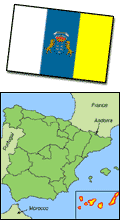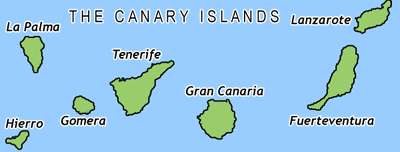 |
 Canary Islands Canary Islands
The Canary Islands are Spain's tropical paradise and for Spaniards
living in mainland Spain they are synonymous with holidays,
as they are for the hundreds and thousands of foreign tourists
who pack the islands' resorts all year round. Colonized and
populated by Spaniards, they lie 1,150km off the coast of Africa.
They are politically and administratively Spanish and yet culturally
and geographically they have very much their own personality.

The Canaries today consist of seven islands divided, for administrative
purposes, into two areas. The province of Las Palmas brings
together the major island of Gran Canaria and the lesser ones
of Lanzarote and Fuerteventura. The province of Santa Cruz
de Tenerife encompasses Tenerife and its satelite islands of
la Gomera. La Palma and Hierro. Within the archipelago there
is a variety so extreme that it is easiest to refer to it as
a mini-continent. The isles share an eternal spring climate
but they differ dramatically amongst each other. Exploring
the Canaries you move from sub-tropical vegetation to volcanic
semi-deserts, from verdant cliffs and gorges to sand dunes
by the sea shore.
One wonders to this day when and how the ancients learnt about
this little paradise which Herodotus called the Garden of Hesperides,
Homer the Elysian Fields and Pliny the Fortunate isles. Modern
contact with the Canaries began to develop in the Middle Ages
as sailors from peninsular Spain arrived to plunder the isles
of their orchids, which were used to make dye, and of their
inhabitants, who were enslaved. Conquest in earnest only began
with the Norman adventurer Jean de Bethencourt who, in 1402,
claimed Lanzarote on behalf of his feudal lord. Henry III of
Castile. In 1483, during the region of the Catholic Monarchs,
Pedro de Vera established a base in Gran Canaria and in 1496
Alonso Fenández de Lugo won control of Tenerife. From
then on colonization started in earnest.
The original inhabitants of the Canaries were a race known
as the Guanches, a name derived from guan, meaning man or people,
and achinch, meaning white mountain in an obvious reference
to Tenerife's snow-capped Mount Teide. The natives lived a
Stone Age existence of shepherding and very rudimentary agriculture.
They buried their dead and, in the case of chieftains, mummified
the, much like the ancient Egyptians. In Tenerife, Bencome,
the mencey or leader of the tribe, fiercely resisted the conquistadors
with his flint exes and slings, while in Gran Canaria the ruling
guanarteme. Semidán, welcomed the European strangers
and established truces.
The isles began to realize their potential for the Crown of
Castile as the links developed with the New World. Right at
the beginning of that awesome period Christopher Columbus,
on his first voyage, rested at La Gomera before venturing into
the unknown, westwards in search of the Indies. Before long
the Canaies were to become the vital link in transatlantic
crossings, a stepping stone between Europe, Africa and the
American continent. Last century, as trade and travel increased,
the first hotels began to open in Tenerife. Since then commerce
and leisure have spread and never ceased developing throughout
the archipelago which still retains the paradisiacal qualities
that earned it such poetic appellations so many centuries ago.
Folklore and crafts
Popular songs and dances have a characteristic cadence, in
which contributions from the Peninsula mingle with a native
basis. An exotic, original feeling is conveyed by the expressive
stances of the dancers, by the many coloured costumes, which
are different on every island, by the rhythm of the melodies
- some of which have airs of a certain languid slowness. The
isa and the folias are the most popular songs and dances, apart
from the malagueña of Andalusian origin, which has taken
root in the Canaries. The typical musical instrument used for
accompaniment is the timple, a kind of ukulele with a harmonious
sound. Crafts mainly take the form of openwork and embroidery,
which are done by Canary women with great skill and refined
taste. It may be said that the first Canary greeting which
the traveller receives upon his arrival in the islands are
examples of this delicate work shown and on sale everywhere.
Pottery also has a long tradition and is of the greatest interest,
as is making baskets with palm leaves, reed and wicker. Delicate
objects are also produced by carving wood.
Shopping
The Canary Islands are a shopping paradise because there is
no joy-cooling customs barrier. Shopping therefore is a pleasure
as never before. Not even the tax-free shops at the airports
can compete with prices in the Canaries. Liqueurs, tobacco,
cameras and film cameras, tape recorders, transistor radios,
watches, everything is cheaper than in their countries of origin.
From Nigerian crocodile skin to ivory carved on the banks of
the Ganges or real Chinese silk, the most curious, rarest objects
can be found.
Sports
The islands are the ideal setting for the practice of all
kinds of sports. There are many fans of underwater fishing,
swimming and whatever other sports there are on the beach and
at the swimming pools. The traveller has a thousand training
possibilities at the tennis courts, trap-shooting, riding clubs
and the magnificent golf courses with a perfect lawn on undulating
terrain. There are also occasions to get to know local sports,
such as cock fights, the game of sticks, a kind of fencing
with two long poles, and the famous Canary catch as-catch-can
of remote origin, which requires great skill and strength and
is a spectacle of major interest. Another tradition is el salto
del regatón or de la garrocha, practiced above all in
the island of La Palma.
Communications
The Canary archipelago is connected with Europe, Africa, but
especially with the Spanish peninsula, by numerous sea and
air links.
The shortest distance between these islands and Africa is
115 Km. From Gran Canaria and Tenerife to the port of Cádiz,
there are 680 and 705 miles, respectively, the equivalent of
two days at sea. Direct flights by jet from Madrid take a little
over two hours. Every island, with the exception of Gomera,
has airports for national and international flights. For the
moment, the airport on the island of El Hierro only receives
national flights. There are numerous air and sea links between
the different islands of the archipelago. Especially between
Tenerife and Gran Canaria there are several air and sea links
every day.
Cooking
Canary cooking includes many dishes prepared with fish caught
in large amounts along the coast. Fish is served with the famous
papas arrugadas, potatoes boiled in salt water, and a hot sauce
called mojo. Traditional dishes are watercress stew, the popular
sancocho canario, made with salted fish and mojo, rabbit in
salmorejo, a sauce consisting of water, vinegar, olive oil,
salt and pepper, sweet black pudding, etc. Banana and tomato,
the main source of wealth of the islands, also occupy an important
place in Canary cooking as do avocado pear and papaya fruit
as well as gofio, a roasted mixture of wheat, maize or barley,
which is eaten with certain dishes of the country instead of
bread. Among the sweets, especially outstanding are tirijalas,
bienmesabes, frangollo, bizcochos lustrados, turrones de melaza
or gofio and pastry. Typical of the island of El Hierro are
quesadillas and of La Palma rapaduras and marquesotes. Among
the drinks produced in the islands, there are especially rum,
rum-cum-honey, malmsey wine and the reds from Tacoronte.
A splendid complement of a Canary meal is the excellent, native
tobacco, world-famous because of the quality and variety of
its tastes, among which the typical cigars, exported to countries
of all kinds, do deserve special mention.
Climate
The Canary Islands have a climate of their own, due in the
first place to their geographical position in the middle of
the Atlantic, near the African coast; secondly, because of
their place in the path of the trade winds, which are responsible
for the peculiar character of their climate, and thirdly, because
of the variety of their geographical features, ie, the more
mountainous islands have more rain, such as Tenerife, La Palma
and Gran Canaria, and the less rugged ones, such as Fuerteventura
and Lanzarote, have less rain. Consequently, the mountains
have a direct bearing on the amount of rain that falls and
not the proximity of the African continent, as is commonly
believed.
All the climatic indicators based on the sensation experienced
by the human body when the values of temperature, humidity
and wind speed are combined coincide in showing that the islands
have the Best possible conditions for eternal spring throughout
the year.
The temperature variations between the different seasons are
especially eye-catching: 6C (42.8F) between the warmest and
the coldest month. The number of really good days varies from
between 90 per cent in August and 50 per cent in January, and
it is typical for them to be mild - between 18 and 24C (64.4
and 75.2F) -, with clean, fresh air, a rather high degree of
humidity (80 per cent) and a partially clouded sky in places
lying east of the mountains and close to them. The less agreeable
days with a southern African wind only account for 7 per cent
(26 days in the whole year). At the same time, its mountainous
features produce temperature changes depending on the altitude
so that even snow is found on some peaks.
The so-called Canary current contributes to the mild climate.
It keeps the surface temperature of the sea below that corresponding
to the latitude. The mean temperature of the sea water is 22
in the summer and 19 in the winter.
As a result of their pleasant spring with a mean temperature
of 18C (64.4F) and their splendid summer with 22C (71.6F),
the climate of these marvelous islands is unmatched and the
feeling of well-being constant.
 |

See
what tours we have available here! |
Book Organized Tours of Spain
Popular tours sell out well in advance! Don't be
disappointed!
Reduce stress! Don't waste time haggling with the hotel concierge.
Lock in your price! Currency dips & price hikes won't effect you.
Save vacation time! Plan & book now, not when you're there.
Balance your vacation budget! Charge tours on this month's credit card bill. |
|

See
what tours we have available here! |
 |
|
 |




